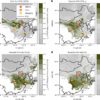Sanitary landfills in Pennsylvania can accept the liquid waste byproducts of drilling and fracking for oil and gas as long as it is “immobilized,” mixed with wood chips or sawdust, for example.
This waste can contain high levels of heavy metals, like arsenic; salts such as chloride and bromide; and naturally occurring radioactive materials.
Sanitary landfills are those designed to let waste decompose; they are not necessarily designed to manage radioactive waste.
A collaborative research study led by Daniel Bain, University of Pittsburgh associate professor of geology and environmental science, analyzed records as well as soil samples to better understand the effects of disposing of this waste in facilities that were not built to contain radioactive waste.
The team, in an article written in Ecological Indicators by Lauren Badertscher, then a masters student at Duquesne University and now with the EPA, found that poor records and a lack of monitoring are a barrier to fully understanding the impact of this method of immobilized oil and gas waste disposal.
Sediment samples taken upstream and downstream from 17 facilities that treat water from landfills in New York, Ohio and Pennsylvania—all states that accepted such waste in 2019, when the samples were taken—often showed elevated levels of radium, implicating the wastewater as a its source.
Discharge permits for these landfills do not commonly require monitoring of materials found in oil and gas waste.
The research team sought out reports to the Pennsylvania Department of Environmental Protection Oil and Gas Division from oil and gas wells, indicating that they shipped wastewater to sanitary landfills in New York, Ohio and Pennsylvania.
They also analyzed records from the environmental agencies of New York, Ohio and Pennsylvania documenting the acceptance of oil and gas wastewater.
When the researchers compared the two, they found that, at the very best, there was still a 30% discrepancy between records of what was sent and what was received.
Almost half of the landfills examined had either a record of shipment or a record of receipt, but no associated record on the other end in 2019. When totaled, these gaps in record keeping leave over 800,000 metric tons of oil and gas waste unaccounted for.
Researchers concluded that insufficient regulatory recordkeeping and a lack of mandatory monitoring and testing are a barrier to fully understanding the impact on local water systems of sanitary landfills accepting wastewater resulting from drilling and fracking for oil and gas.
“The mismatch in regulatory records creates the potential for contamination,” Bain said. “And while we don’t have the data to unambiguously tie increases in stream sediment radium to disposal of these wastes in landfills, the observations clearly indicated we should really start scrutinizing, and probably rethink, the disposal of oil and gas waste in landfills.”
More information:
Lauren M. Badertscher et al, Elevated sediment radionuclide concentrations downstream of facilities treating leachate from landfills accepting oil and gas waste, Ecological Indicators (2023). DOI: 10.1016/j.ecolind.2023.110616
Provided by
University of Pittsburgh
Citation:
Study finds 800,000 tons of drilling, fracking waste unnaccounted for in NY, PA, Ohio (2023, July 19)



